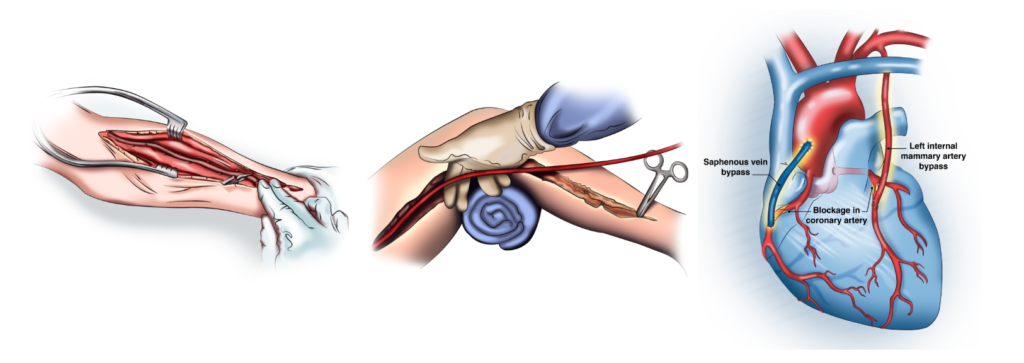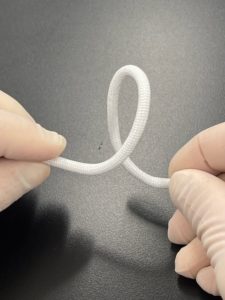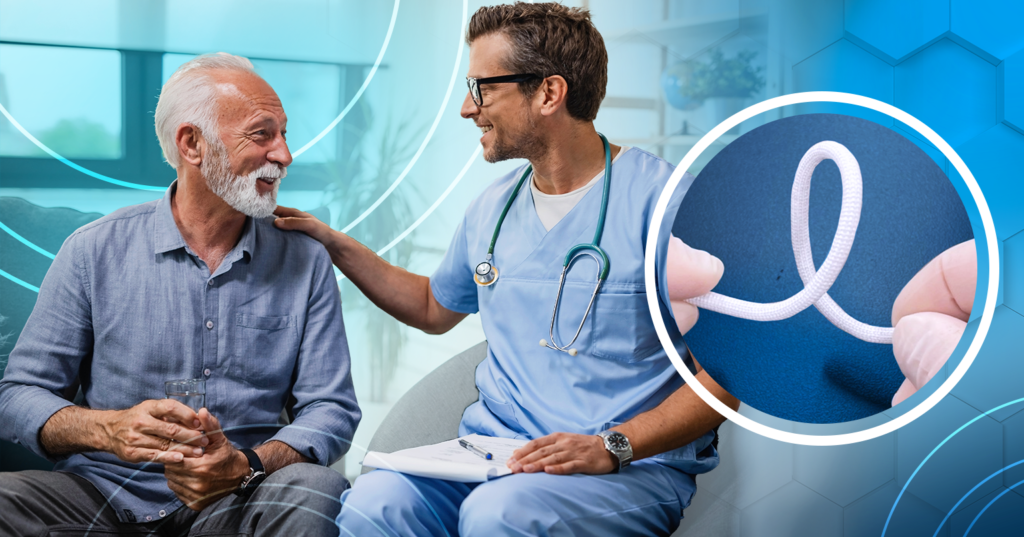Medical 21 replaces vessel harvesting, invasive leg surgery, and post-op complications with its small-diameter MAVERICS graft.
A Global Issue
Cardiovascular disease (CVD) is the #1 cause of death worldwide. According to the CDC, heart disease kills one person every 36 seconds in the United States. Over two billion adults have a risk for heart disease, a result of worldwide obesity tripling since 1975.
Often dubbed “the silent killer,” cardiovascular disease refers to several heart disorders including:
- Coronary Artery Disease (CAD): damage to the heart’s major blood vessels; coronary arteries struggle to send enough blood, oxygen, and nutrients to the heart muscle
- High blood pressure
- Cardiac arrest, also known as a heart attack
- Congestive heart failure: a chronic condition that causes the heart to pump blood inefficiently
- Arrhythmia: an irregular beating of the heart
- Strokes
- Congenital heart disease: a birth defect that causes abnormality in the heart
- Peripheral artery disease: narrowed blood vessels to the limbs
Cardiac Bypass Surgery
Cardiac bypass surgery is a surgical procedure that redirects blood flow in the heart when the patient has narrowing or blockages of one or more coronary arteries. It creates a new path for blood to flow to the heart, with the goal of improving heart function and restoring proper circulation to the cardiovascular system. There are approximately 800,000–1,000,000 cardiac bypass surgeries performed each year globally.
CABG Surgery: A Grueling Procedure
Coronary artery bypass grafting (CABG) is the most common cardiac procedure worldwide.
This life-saving procedure is a long, painful process for patients. In order to create a new pathway for blood flow, surgeons must first harvest a healthy blood vessel from a patient’s arm, leg, or breast. They use the harvested vessel as a graft in the heart to bypass the blocked arteries and restore proper blood flow.

A Painful Recovery
I’m sure you can imagine how unpleasant this procedure must be for patients. Recovery can be long and come with a host of issues, including:
- Discomfort: patients have reported more discomfort from their leg incision than the sternal wound from the bypass procedure.
- Pain: patients have to recover not only from a heart surgery, but from another invasive procedure in their arm, leg, or chest where part of their blood vessel was removed. It is common that more than one leg is opened to harvest a healthy vessel.
- Various wound healing complications, including possible infection.
- Disfigurement: vessel harvesting is highly invasive, often requiring an incision from the patient’s ankle to the groin; or incisions in the ankle, knee, and groin for endoscopic harvesting.
- Many patients have reported having to relearn how to walk properly or having numbness in their arms and legs.
Not Everyone Is Eligible for Life-Saving CABG Surgery
In order to perform a coronary artery bypass graft, surgeons need healthy veins to harvest. This, unfortunately, makes a lot of patients ineligible for the procedure.
Patients who do not have healthy saphenous veins or any harvestable veins cannot undergo this life-saving procedure. This includes patients with:
- Amputations
- Varicose veins
- Severe diabetes
Medical 21: On a Mission to Eliminate a Painful Step
The cardiac bypass surgery procedure has not been updated in over 50 years. It is the most common cardiac procedure — nearly one million surgeries are performed every year — yet it remains painful and sometimes inaccessible.
Medical 21 aims to change that. We have developed a small-diameter graft designed to eliminate the need for vessel harvesting in CABG surgery.
A Master Entrepreneur’s Dedication
Dr. Manny Villafaña, Ph.D.Sc., has advanced cardiac medical devices for over 50 years. His contributions to the medtech field have created lasting change and positively impacted the lives of millions of people around the world.
Before he founded his first company, Cardiac Pacemakers, Inc. (CPI)/Guidant in 1972, implantable pacemakers would only last around 18 months. He knew there was a dire need for a better pacemaker, one that could last 10 years. Everyone told him it was impossible to do. Disregarding the naysayers, he eventually invented the first long-life lithium-powered pacemakers — they lasted 30 to 40 years. The technology he and his team developed in 1972 is incorporated into virtually every pacemaker and defibrillator today.
Over the last 50 years, Manny has continued to innovate outdated, inefficient cardiac devices. From pacemakers to heart valves, The Living Legend of Medicine has made it his life’s work to heal hearts through his advancements. His latest venture, Medical 21, seeks to make an even bigger leap forward.
MAVERICS: A Graft for All Hearts
The MAVERICS graft is a small, flexible tube encased in a nitinol scaffold that replaces the need for blood vessel harvesting in the heart bypass surgery patient, creating a more efficient, cost-effective, and less invasive procedure.
This advancement could finally open the door for previously ineligible patients to receive cardiac bypass surgery. Veterans with amputations, a beloved aunt with varicose veins, a father with severe diabetes — all would be able to receive life-saving surgery. A patient’s veins, or lack thereof, would no longer be a roadblock to a healthy heart. We believe all hearts should be eligible, regardless of the condition of a patient’s veins.
There’s a reason the procedure has not been updated in 50 years. Many companies have tried to develop an artificial graft but have come up short. Hearts are incredibly difficult to replicate and repair. Your heart pumps about 40 million times per year, which puts incredible pressure on the vascular system. Grafts need to be just as strong and flexible to sustain the contractions and constant movements of a patient’s circulatory system.
Our graft is biocompatible, stronger, and more flexible than any test of similar technology thus far, and is designed to allow for a less intrusive surgery.
 By eliminating the need for vessel harvesting, the MAVERICS graft has the potential to:
By eliminating the need for vessel harvesting, the MAVERICS graft has the potential to:
- Reduce a patient’s pain and discomfort
- Reduce wound healing complications, including disfigurement
- Shorten a patient’s post-op time in the ICU/hospital
- Shorten operating time for surgeons, allowing more procedures to be performed by the surgeons
- Open the door for all patients to receive cardiac bypass surgery, regardless of the condition of their arteries and veins
Be a Part of Advancing the Cardiac Bypass Surgery Procedure
Medical 21 is currently conducting a Private Placement financing to fund our clinical trials and market launch.
Every one of us — whether directly or indirectly — will be affected by heart disease at some point in our lives. With heart disease as the #1 killer, there is a dire need to advance this grueling procedure. Our graft has the potential to positively impact countless lives. Each CABG surgery requires an average of 3 to 4 grafts, which creates a global need for two to three million grafts per year.
If you want more information, please fill out our Contact Us form.
References
https://www.mordorintelligence.com/industry-reports/coronary-artery-bypass-grafting-market
https://www.ncbi.nlm.nih.gov/pmc/articles/PMC5906252/
https://www.ncbi.nlm.nih.gov/pmc/articles/PMC4276481/
https://www.cdc.gov/heartdisease/facts.htm
https://www.ncbi.nlm.nih.gov/pmc/articles/PMC3741873/
https://www.uofmhealth.org/health-library/ue4718abc
https://www.ahajournals.org/doi/10.1161/01.CIR.0000044747.37349.64
https://www.heartfoundation.org.au/recovery-and-support/heart-bypass-surgery
https://www.nhs.uk/conditions/coronary-artery-bypass-graft-cabg/
https://emedicine.medscape.com/article/150215-overview
https://www.ncbi.nlm.nih.gov/pmc/articles/PMC4276481/
https://www.ncbi.nlm.nih.gov/pmc/articles/PMC6956319/
https://pubmed.ncbi.nlm.nih.gov/8076087/
https://www.uofmhealth.org/health-library/hw101095
https://www.svhhearthealth.com.au/rehabilitation/after-cardiac-bypass-surgery
https://www.mayoclinic.org/tests-procedures/coronary-bypass-surgery/about/pac-20384589
